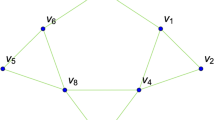Abstract
In 1974, A. Sampson [16] gave a rather technical matrix-theoretic proof that any complex matrix of determinant ±1 can be written as a product of finitely many involutions. A brash, young (at the time) algebraist, I quickly saw a group-theoretic proof that gives the same result for matrices over any field, and involves very little computation. Indeed, my proof occupied one and a half typed pages, most of it devoted to a couple of special cases. I sent a copy off to Hans Schneider for publication in Linear Algebra and its Applications, and distributed copies in the mailboxes of a few selected colleagues. One of those colleagues was Paul Halmos (that was a different time and place for both of us). A few hours later, Paul passed me in the hall.
Access this chapter
Tax calculation will be finalised at checkout
Purchases are for personal use only
Preview
Unable to display preview. Download preview PDF.
Similar content being viewed by others
References
C. Ballantine, Some involutory similarities, Linear Multilinear Algebra 3 (1975), 19–23; addendum, ibid. 4 (1976), 69.
C. Ballantine, Products of involutory matrices I, Linear Multilinear Algebra 5 (1977), 53–62.
H. Bass, Some Problems in “Classical ”Algebraic K-Theory, Lecture Notes in Mathematics, Springer-Verlag, New York, 1973, Vol. 342. pp. 3–73.
J. Berggren, Finite groups in which every element is conjugate to its inverse, Pacific J. Math. 28 (1969), 289–293.
J. Berggren, Solvable and supersolvable groups in which every element is conjugate to its inverse, Pacific J. Math. 37 (1971), 21–27.
D. Djokovic, Products of two involutions, Arch. Math. 18 (1967), 582–584.
E. Ellers, Products of two involutory matrices over skewfields, Linear Algebra Appl. 26 (1979), 59–63.
R. Guralnick, Similarity of matrices over local rings, Linear Algebra Appl. 41 (1981), 161–174.
W. Gustafson, P. Halmos, and H. Radjavi, Products of involutions, Linear Algebra Appl. 13 (1976), 157–162.
P. Halmos,I Want to be a Mathematician, Springer-Verlag, New York, 1985.
P. Halmos and S. Kakutani, Products of symmetries, Bull. Am. Math. Soc. 64 (1958), 77–78.
G. Higman, B. Neumann, and H. Neumann, Embedding theorems for groups, J. London Math. Soc. 24 (1949), 247–254.
F. Hoffman and E. Paige, Products of involutions in the general linear group, Indiana Univ. Math. J. 20 (1971), 1017–1020.
A. Kerber, Representations of Permutation Groups I, Lecture Notes in Mathematics, Springer-Verlag, New York, 1971, Vol. 240.
K. Liu, Decompositions of matrices into three involutions, Linear Algebra Appl. 111 (1988), 1–24.
A. Sampson, A note on a new matrix decomposition, Linear Algebra Appl. 8 (1974), 459–463.
W. Scott, Group Theory, Prentice-Hall, Englewood Cliffs, New Jersey, 1964.
A. Sourour, A factorization theorem for matrices, Linear Multilinear Algebra 19 (1986), 141–147.
W. Waterhouse, Solution of advanced problem 5876, Am. Math. Monthly 81 (1974), p. 1035.
M. Wonenburger, Transformations which are products of two involutions, J. Math. Mech. 16 (1966), 327–338.
Author information
Authors and Affiliations
Editor information
Editors and Affiliations
Rights and permissions
Copyright information
© 1991 Springer Science+Business Media New York
About this chapter
Cite this chapter
Gustafson, W.H. (1991). On Products of Involutions. In: Ewing, J.H., Gehring, F.W. (eds) PAUL HALMOS Celebrating 50 Years of Mathematics. Springer, New York, NY. https://doi.org/10.1007/978-1-4612-0967-6_27
Download citation
DOI: https://doi.org/10.1007/978-1-4612-0967-6_27
Publisher Name: Springer, New York, NY
Print ISBN: 978-1-4612-6964-9
Online ISBN: 978-1-4612-0967-6
eBook Packages: Springer Book Archive



